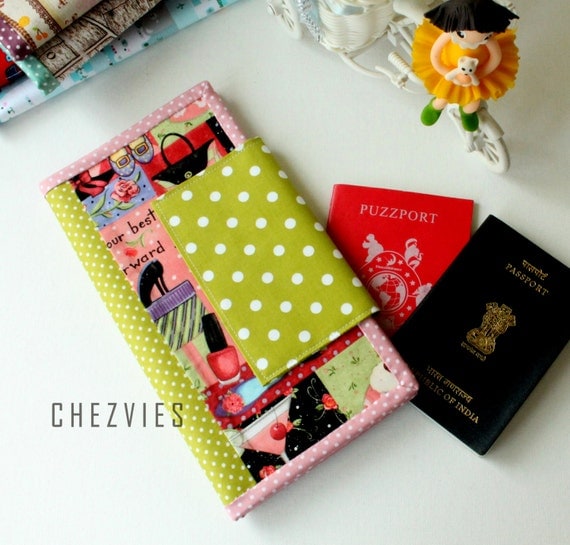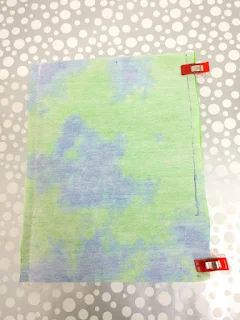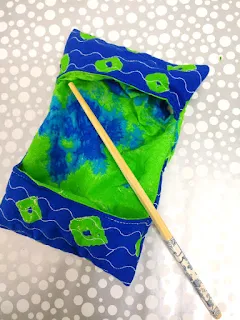Hello and welcome to TGIFF!
This week, I'm sharing a tutorial for foldover sling bag.
This week, I'm sharing a tutorial for foldover sling bag.
A few weeks ago, hubby's aunt came and she said her morning walk friend wanted a sling bag like the one I made for her. It's a simple foldable sling bag with elastic closure. Very light and handy.
UPDATE : Download the PdF version HERE
UPDATE : Download the PdF version HERE
So, here is what you need:
- Assorted of fabrics for exterior and lining
- batting (you can use fleece, flannel or cotton)
- Fusible lightweight interfacing (skip this if you are using fusible batting)
- Elastic cord or hair band
- Large Button
- Grosgrain ribbon
- Woven Interfacing Strip
- Swivel hook 0.5"
Measurement and cut
- Exterior Fabric :
Top Panels 8" W x 3" H - cut 2
Bottom Panel 8" W x 8.5" H- Cut 2
- Interfacing : 8" W x 22" H - Cut 1
- Lining Fabric : 8" W x 22" H - cut 1
- Batting : 9" W x 23" H - Cut 1
- 0.5"Wide Ribbon : 2" Long - cut 2
- Strap Fabric : 2" W x 44" H - cut 1
- Woven Interfacing Strip 1" x 43 - cut 1
*RST - Right Side Together
Let's sew :
1. Sew the top and bottom panel together on the 8" side (RST) with 3/8" seam allowance.
2. Sew the bottom of both exterior panel together (RST) using 3/8" seam allowance. You will get a long piece of exterior panel 8" W x 22" H.
3. Fuse the interfacing on the wrong side of the exterior panel and then place the it on the batting Right Side Up and pin generously. The pins will prevent the fabric from shifting while you quilt it. Quilt as desired. Once you finished with the quilting, trim the excess batting.

I'm not very fond of free motion quilting, so I always use my walking foot. I quilted my bag using organic wavy lines approximately 0.5" apart. Walking foot is just awesome! It goes through layers effortlessly like this bag and this bag.
4. Fold and attach the ribbons on the longer sides of exterior panel. Place it on the bottom panel part, just under the stitching line between the top and bottom part.

5 . Fold the elastic cord and make a knot. Center it on one of the exterior panel top edge. Top stitch with 1/8" Seam allowance. Run a couple stitch and back stitch to secure it.

6. Put the lining and exterior panels RST and sew the short edges (top) together with 3/8" seam allowance. Repeat with the other short edge.
7. Turn the bag inside out , pull the lining away from the exterior. Press the seam towards the exterior side and top stitch with 1/8" Seam Allowance.

It should look like the picture below.

On the wrong side , it should look like the picture below.
Do not cut the knot.

8. Now pull out the lining and exterior panels separately, so that they are on opposite side. Match the top seam and secure it with wonder clips.

9. Sew the longer side starting from the exterior panel with 3/8" seam allowance. Repeat with the other long side, but leave a gap around 4" or so for turning. Don't forget to back stitch at the beginning and end .
10. Diagonally cut the corners and turn the bag inside out through the opening, iron it and sew the opening closed.

Make the strap:
1. Center and fuse the interfacing on the wrong side of the strap fabric. You can opt out for the interfacing if using thicker fabric. Since I was using thin linen, I use 1" woven interfacing strip.
2. Fold it lengthwise and press to create a middle crease. Open the fold. (DIAGRAM A)
3. Fold in both short ends by 1/2” and fold both raw edges lengthwise towards the middle crease. (DIAGRAM B)
4.Press and fold it in half lengthwise again. Top stitch on both long edges with 1/8” seam allowance. (DIAGRAM C)
5. Install the swivel hooks on both ends of the straps and stitch the strap to secure it.

6. Sew fancy wooden button on the front of the bag. Fold top of the bag and mark the placement as you desired. And it’s done!! Yay!!

2. Fold it lengthwise and press to create a middle crease. Open the fold. (DIAGRAM A)
3. Fold in both short ends by 1/2” and fold both raw edges lengthwise towards the middle crease. (DIAGRAM B)
4.Press and fold it in half lengthwise again. Top stitch on both long edges with 1/8” seam allowance. (DIAGRAM C)
5. Install the swivel hooks on both ends of the straps and stitch the strap to secure it.

6. Sew fancy wooden button on the front of the bag. Fold top of the bag and mark the placement as you desired. And it’s done!! Yay!!

Do tag me on Instagram @chezvies if you make one!
Now, it's your turn to link up and show us your finish this week! Click the blue button below and start sharing~
Happy Sewing
Elvira
Now, it's your turn to link up and show us your finish this week! Click the blue button below and start sharing~
Happy Sewing
Elvira






















































